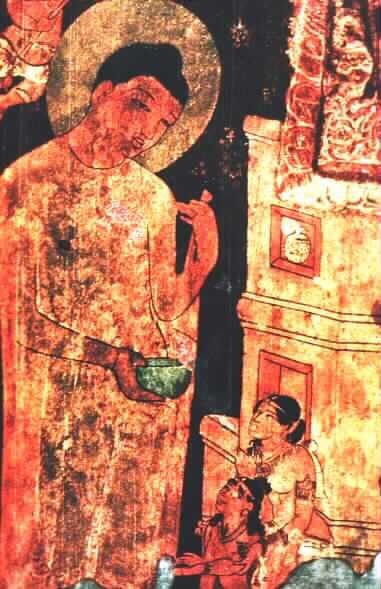Buddha begging for food in front of his wife Yashodhara and his son Rahula. Cave 17, Ajanta. From personal.carthage.edu
Yashodhara, which means “Bearer of Glory,” was the wife of Prince Siddhartha and the mother of their son, Rahula. She was born in the Sun Clan, to the daughter of King Suppabuddha and Amita. Amita was the sister of the Buddha’s father, Suddhodhana. Both families belonged to royal families who could only marry each other. Yashodhara was born on same day as Siddhartha, and after the enlightenment of her husband she followed his example and became a bhikshuni (nun). She is accepted as one of the most important women in early Buddhism who have achieved the state of arhat with extraordinary powers.
The Mahavastu, the central text of the Lokottaravada School of Early Buddhism, mentions that Buddha’s wife in his last rebirth is the same from his previous lives. There are many different stories about their encounters in the distant past. According to The Collective Sutra of the Buddha’s Past Acts, Yashodhara met Prince Siddhartha for the first time in a previous life when he was a young Brahmin named Sumedha, and she was a beautiful girl named Sumidha. Waiting for Buddha Dipankara in the city of Paduma, Sumedha tried to buy flowers and offer to him but found out that the king has bought all the flowers for his own offering. Then he saw Sumidha holding seven lotus flowers in her hands. He asked her to buy one of her flowers, and she promised to give him five of her lotuses if he would promise to become her husband in all their next lives.
According to another legend, Prince Siddhartha/Sumedha went to the city where everybody was expecting Buddha Dipankara. Then he saw a beautiful girl with lotuses in her hands and asked her for one flower. She gave him all her flowers and told him that when she saw him she realized she was ready to give him everything. They went to listen the wise words of Dipankara, along with a huge gathering of people. Sumedha threw one of the lotuses to him and it fell right at his feet. The girl asked Sumedha to throw another flower on her behalf and it also fell to his feet. Then, Dipankara summoned both of them and told them that they would be together in many lifetimes and help each other in achieving enlightenment. In their last life they were reborn again as husband and wife.
Despite her divine beauty, spiritual merit, and the superhuman powers she developed as a nun, and despite giving birth to Buddha’s only son, Yasodhara remains in the shadow of her great husband. In his last rebirth, after attaining enlightenment, Buddha Shakyamuni predicted that in the future his wife would also attain this state. The numerous relationships between Buddha and Yashodhara show that his beautiful wife gained tremendous merits in her past lives to be re-elected as his beloved. Thus the Buddhist belief in numerous rebirths is complemented by the notion that when a couple shares strong mutual love and spiritual qualities, they can remain connected in their succeeding lifetimes until both attain the eternal peace of nirvana.
One the most famous images of Yashodhara can be seen at the murals of Ajanta Caves in Aurangabad district of Maharashtra State, India. Cave 17 shows the Buddha begging for food at his former home, standing in front of his wife and his son Rahula. The body of the Buddha is shown to be much larger, emphasizes the supremacy of his spiritual status.

